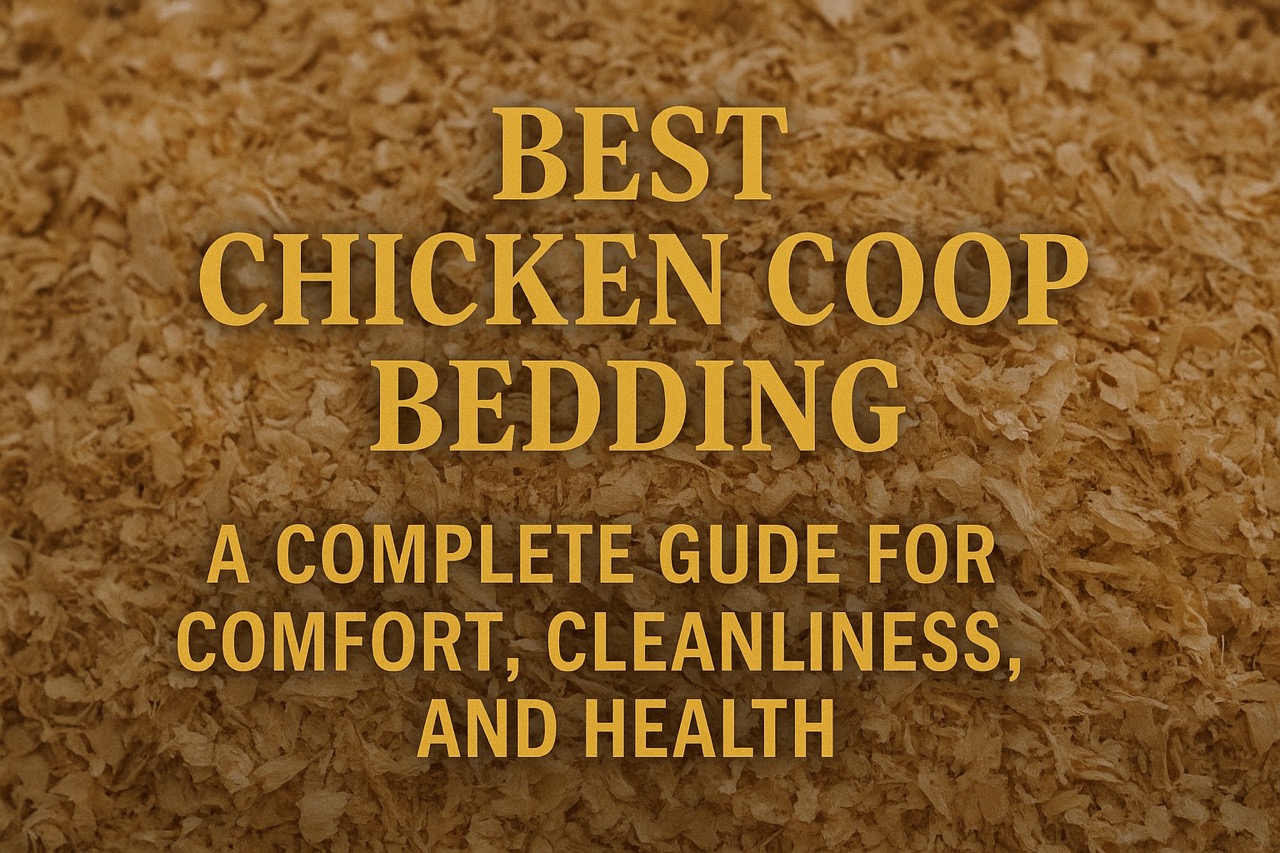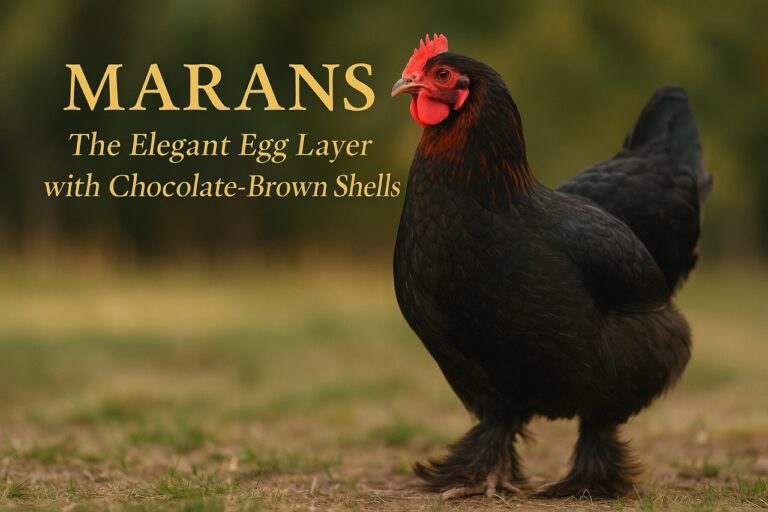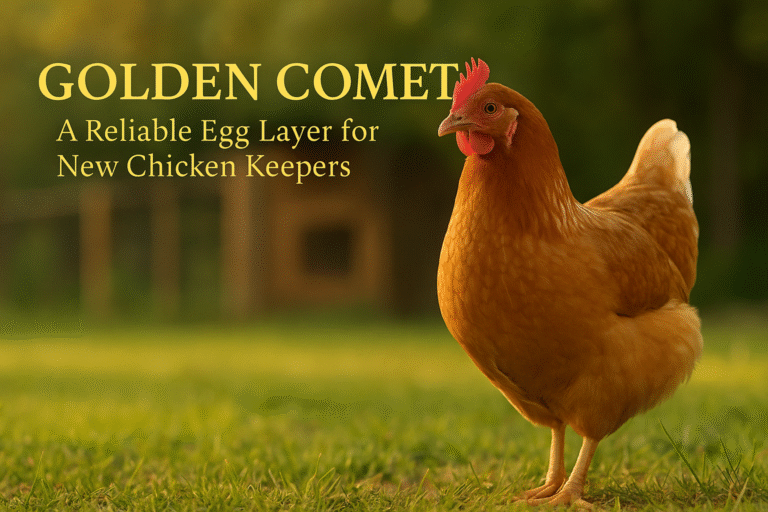Choosing the best chicken coop bedding is one of the most important decisions a backyard poultry keeper can make. The right bedding material controls odor, absorbs moisture, reduces pests, and supports your chickens’ comfort and health. Whether your priorities are low cost, high absorbency, eco-friendliness, or seasonal adaptability, this updated guide will help you select the perfect bedding or blend for your flock.
🏡 Top Chicken Coop Bedding Options (Ranked & Compared)
1. Hemp Bedding — Best Overall Bedding
- Pros: Extremely absorbent, low dust, excellent odor control, long-lasting, compostable.
- Cons: Higher cost, limited availability in local stores.
- Why It Works: Hemp absorbs 4x its weight in moisture, making it one of the most effective options for coop cleanliness. It breaks down well in compost and supports respiratory health.
2. Pine Shavings — Popular, Comfortable Choice
- Pros: Readily available, good absorbency, controls odor, soft texture.
- Cons: Can be dusty; requires frequent replacing; costs more than straw.
- Why It Works: Pine is a trusted standby that balances absorbency, smell control, and comfort. Just avoid cedar, which can irritate chickens’ lungs.
3. Sand — Low-Maintenance for Dry Climates
- Pros: Long-lasting, great drainage, easy to clean with a scoop.
- Cons: Cold in winter, heavy to install, lacks insulation.
- Why It Works: In hot, dry regions, sand is ideal for keeping bacteria and odor at bay. Not recommended for wet or cold climates.
4. Straw — Insulating & Affordable
- Pros: Budget-friendly, insulating in winter, compostable.
- Cons: Molds quickly if wet, attracts pests, poor absorbency.
- Why It Works: Ideal for colder seasons. Use straw in combination with other materials (like sand or hemp) to offset its weaknesses.
5. Coco Coir — Eco-Friendly and Absorbent
- Pros: Sustainable, soft, good moisture control, composts easily.
- Cons: Expensive, limited local availability.
- Why It Works: A renewable, breathable bedding option that reduces odor and helps maintain a clean environment.
6. Pine Needles
- Pros: Free if foraged, naturally fragrant, compost-friendly.
- Cons: Low absorbency, sharp texture, needs frequent changes.
- Best For: Seasonal supplementation in fall and early winter.
7. Mulch/Wood Chips
- Pros: Durable, controls mud in outdoor runs, reusable.
- Cons: Not very absorbent, rough for indoor coops.
- Best For: Outdoor runs and mud management.
8. Recycled Cardboard
- Pros: Affordable, low dust, eco-friendly.
- Cons: Not very absorbent, can clump, needs regular cleaning.
- Tip: Use shredded cardboard as a layering base with other materials.
9. Leaves
- Pros: Free in autumn, compostable, fun for foraging.
- Cons: Low moisture control, short lifespan.
- Tip: Great for short-term enrichment, not ideal as a primary bedding.
10. Shredded Paper
- Pros: Cheap, soft, recyclable.
- Cons: Gets soggy, can mold, frequent replacement needed.
- Best For: Emergency or short-term use only.
11. Hay
- Pros: Comfortable and warm, chickens love to scratch.
- Cons: Molds quickly, attracts pests, costly as bedding.
- Caution: Use only if kept very dry and changed often.
⚖️ Best Bedding Combinations (For Custom Coops)
- Hemp + Pine Shavings: Increases absorbency and softness; long-lasting and clean.
- Sand + Straw: Great for cold climates; sand on bottom for drainage, straw for insulation.
- Pine Needles + Cardboard: Cost-effective and compostable, but requires close monitoring.
📈 Bedding Comparison Table
| Bedding Type | Absorbency | Odor Control | Dust Level | Compostable | Cost | Best For |
|---|---|---|---|---|---|---|
| Hemp | Excellent | Excellent | Very Low | Yes | $$$ | Overall coop bedding |
| Pine Shavings | Good | Good | Medium | Yes | $$ | Most standard coops |
| Sand | Medium | Excellent | Low | No | $$ | Dry/hot climates |
| Straw | Poor | Fair | Low | Yes | $ | Winter use |
| Coco Coir | Excellent | Good | Low | Yes | $$$ | Eco-conscious keepers |
| Pine Needles | Low | Good | Medium | Yes | Free | Seasonal addition |
| Wood Chips/Mulch | Poor | Fair | Low | Yes | $$ | Outdoor run areas |
| Recycled Cardboard | Moderate | Fair | Low | Yes | $ | Mixing with other types |
| Leaves | Poor | Fair | Low | Yes | Free | Autumn enrichment |
| Shredded Paper | Poor | Poor | Medium | Yes | Free | Emergency bedding |
| Hay | Poor | Good | Low | Yes | $$ | Occasional winter use |
🤔 Final Tips
- Avoid cedar shavings: Cedar oils are toxic to chickens.
- Rotate bedding materials seasonally for comfort and odor control.
- Use the deep litter method with dry, absorbent materials like hemp or pine to generate heat in winter.
- Regularly clean and compost bedding to prevent ammonia buildup and respiratory issues.
🧠 Darwin’s Take: The Bedding That Binds Us
Bedding might seem like just another chore, but it mirrors how we build environments for the lives we care for. It’s not only about warmth or dryness—it’s about stewardship. Beneath the pine, straw, or hemp lies a truth: small choices shape entire ecosystems. A coop is a microcosm. Choose wisely.
More Reading on Paranoid Prophet
Wheatgrass Hay & Winter Chickens: Learn about the benefits of wheatgrass hay for your chickens during the winter months. This article explores how adding wheatgrass to their diet can enhance your flock’s nutrition and overall health, helping them thrive through colder seasons.
Winter Chicken Memes and Facts: Dive deeper into the lighter side of chicken care with a collection of winter-themed chicken memes and fun facts about how chickens handle the cold. You’ll discover amusing insights and practical tips for your feathered friends in winter.
Poultry Care & Backyard Flocks: Explore the full range of poultry care content, where you’ll find articles on optimizing your backyard flock’s health, well-being, and happiness. Whether you’re new to raising chickens or a seasoned keeper, this section provides valuable advice for every aspect of chicken ownership.
Sources
Selecting the appropriate bedding for your chicken coop is crucial for maintaining a healthy and comfortable environment for your flock. The following sources provide comprehensive insights into various bedding options, their benefits, and considerations:
- “The Best (& Worst) Chicken Coop Bedding: Your Options” – Backyard Chicken Project
This article evaluates different bedding materials, highlighting the advantages of pine shavings and the potential respiratory risks associated with cedar shavings. Backyard Chicken Project - “8 Best Bedding Options for Your Chicken Coop” – Daily Chickens
This resource provides a detailed analysis of bedding options such as straw, pine shavings, and sand, considering factors like absorbency, odor control, and ease of maintenance. Daily Chickens
These sources collectively provide valuable information to help you make informed decisions about the best bedding options for your chicken coop, ensuring the well-being of your flock.
FAQ: Best Chicken Coop Bedding Guide
General Questions
1. Why is choosing the right bedding important for a chicken coop?
Proper bedding helps maintain a clean, odor-free environment, reduces the risk of diseases, and provides comfort for your chickens.
2. What are the most common types of chicken coop bedding?
The most popular types include straw, wood shavings, sand, shredded paper, and hemp. Each has its pros and cons depending on your climate and flock needs.
3. How often should I change the bedding in a chicken coop?
For most bedding types, it’s recommended to change it every 1-2 weeks, or sooner if it becomes damp or soiled. Deep litter methods may require less frequent changes.
Specific Bedding Types
4. Is straw good bedding for chickens?
Straw is affordable and insulating, making it great for colder climates. However, it can become moldy if wet and isn’t as absorbent as other materials.
5. Are wood shavings safe for chickens?
Yes, pine shavings are safe and highly absorbent. However, avoid cedar shavings, as their strong scent can irritate chickens’ respiratory systems.
6. Can I use sand in my chicken coop?
Yes, sand is an excellent option for hot climates as it stays cool and drains moisture well. However, it requires regular raking to remove droppings.
7. Is hemp bedding worth the cost?
Hemp bedding is highly absorbent, dust-free, and lasts longer than most other options. While it’s more expensive upfront, it may save money over time due to its durability.
8. Can shredded paper be used as bedding?
Shredded paper is an affordable and eco-friendly option, but it isn’t very absorbent and can become damp quickly, requiring frequent changes.
Deep Litter Method
9. What is the deep litter method?
The deep litter method involves layering bedding material and allowing it to compost over time. It reduces waste, generates heat, and requires less frequent cleaning.
10. What bedding works best for the deep litter method?
Wood shavings or straw are ideal for this method because they compost well and provide insulation.
11. How often should I turn the bedding in the deep litter method?
You should turn the bedding weekly to aerate it and speed up composting. Add fresh bedding as needed to cover droppings.
Maintenance and Cleaning
12. How do I keep coop bedding dry?
Ensure proper ventilation, repair any leaks, and use absorbent bedding like wood shavings or sand to keep moisture levels low.
13. Can I compost used chicken bedding?
Yes, chicken bedding mixed with droppings makes an excellent addition to a compost pile. Allow it to compost fully before using it in gardens to prevent burning plants.
14. What are the signs of poor bedding choice?
If your coop has strong odors, excessive dust, dampness, or chickens appear uncomfortable, it may indicate the need to change bedding types.
Seasonal Considerations
15. What’s the best bedding for winter?
Straw and wood shavings provide good insulation during colder months. The deep litter method can also help generate warmth.
16. What’s the best bedding for summer?
Sand works well in summer as it stays cool and allows for quick drainage, keeping the coop dry and comfortable.




